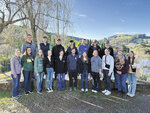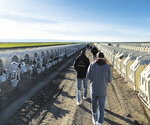

ST. PAUL, Minn. — Nineteen University of Minnesota seniors broadened their experiences in the dairy industry Jan. 6-15 when they took part in this year’s annual Gopher Dairy Club trip to California. The event included visits to nine dairy farms as well as other agricultural sites.
Drs. Isaac Salfer and Isaac Haagen are the co-advisors of the Gopher Dairy Club and served as chaperones for the student-organized trip.
“The trip is really a co-curricular activity to provide educational experiences and leadership opportunities for the students outside of the experiences they would get in the classroom,” Salfer said. “A main reason why it exists is to expose students to the broader dairy industry outside of the Midwest.”
Kate Meyer, majoring in agricultural communication and marketing with a minor in agronomy, and Isaac Rott, majoring in animal science, are seniors in the dairy club who organized this year’s trip.
“As a planner, my goal was to expose the members to dairy and agriculture in California and show them around the cities to see as many attractions as possible,” Meyer said. “As an attendee, I was interested in learning about dairy farming in California, specifically cow comfort, how they utilize byproducts in their rations and what regulations they have.”
Rott said he was surprised by what California dairy farmers feed their cows.
“The highlight of the trip for me was visiting a 10,000-cow dairy that fed a variety of interesting food byproducts including pomegranates, bakery byproducts, citrus pulp and nacho cheese,” Rott said. “My biggest takeaway from the trip was that dairy farming throughout the country looks very different from the Midwest, but the passion for the dairy industry remains strong throughout the country.”
The choice of California as the yearly destination for the trip is purposeful, Salfer said.
“California, for many years, has been the No. 1 dairy-cow and milk-producing state in the U.S., and there are many differences in how farms are managed there,” Salfer said. “In particular, students were exposed to western-style dairies with cows housed on dry lots and saw much more variety in feed ingredients being used due to lower availability of corn silage and soybean meal. The club also has some highly active students who didn’t grow up on dairy farms, so for them, the trip was valuable just for gaining experience seeing a variety of types of farms.”
That experience includes visiting some of the country’s largest dairies and observing unique challenges that dairy farmers and others in the agricultural industry face across their state.
“Overall production costs are much higher in California because of the $16.50 minimum wage, stricter overtime laws, more expensive input costs and regulations on water usage,” Salfer said. “Nearly all farmers we spoke to discussed the importance of managing water supply and recycling water because of California droughts in 2021 and 2022, which resulted in tight control over how much water from their aquifers can be used.”
Seeing what is happening in California’s agriculture industry can be beneficial to farmers in other parts of the country or even globally, Salfer said.
“In some ways, including politically and environmentally, California can predict changes in the dairy industry that could happen in other parts of the country — for better or for worse,” Salfer said. “Some of the ways they have dealt with their state’s labor and environmental laws can be informative to students looking to enter the dairy industry who may experience these issues in the future. Furthermore, by visiting the largest and most diverse agricultural state in the U.S., the trip helped students develop a broader sense of the agricultural industry.”
Besides visiting nine dairy farms and a calf ranch, students also toured an almond processing plant, cheese plant, winery and olive oil farm.
“Seeing the production of commodities that are not grown in the Midwest was cool for the students,” Salfer said.
Students also bookended their farm visits with overnight stays in San Francisco at the beginning of the trip and Los Angeles at the end.
“The primary objective was learning about dairy farming and other forms of agriculture, but the trip is also structured to provide students with other experiences and opportunities for social development within San Francisco and Los Angeles,” Salfer said. “In San Francisco, students visited Fisherman’s Warf and Alcatraz prison, and in Los Angeles, they visited Universal Studios, went to an off-Broadway musical and toured Hollywood.”
During farm visits, students took time to hone their dairy skills.
“We did a lot of work practicing consulting-type skills on the farms,” Salfer said. “Being able to go to a farm that students had never seen before and being able to assess good management practices versus bad management practices also provided value.”
According to the UMN’s website, the Gopher Dairy Club is the largest student-run organization on the Twin Cities campus. The California trip is offered each year to seniors who have shown dedication to the club’s efforts.
“It’s a reward for the students who stay active in the club throughout their time at the university, including participation in our fundraiser and helping with youth contests and camps,” Salfer said.
In a typical year, around 75-80 students are in the club. The club’s biggest fundraiser is a malt stand outside the dairy barn on campus that is run by members during the Minnesota State Fair.
“The club’s activities include running various on-campus events such as the invitational FFA judging contest in fall, state FFA contest in spring, the Gopher Dairy Camp (in summer) for youth and other similar events,” Salfer said. “We also give students opportunities to develop skills in financial management, agricultural marketing and promotions, and development of knowledge about the dairy industry. The club also puts on its own annual career networking event for livestock-focused students across the university called the Food Animal Networking Evening.”
The California trip is usually chaperoned by dairy club alumni, but as new advisors, Salfer and Haagen chaperoned the recent trip.
“I was a member of the dairy club when I was a student here at the University of Minnesota, and Isaac Haagen was very involved in the Penn State Dairy Science Club during his undergraduate studies,” Salfer said. “We both have a passion for dairy youth, and we chaperoned the trip this year because, as new advisors, we wanted to understand the trip experience for students.”
Some of the fun experiences that the trip afforded were accidental, such as what they saw while driving through San Francisco, Salfer said.
“The students got to see a self-driving car — which was exciting for me too because it is not something I had ever (witnessed) before,” Salfer said. “That was pretty crazy to see.”
Mostly, however, the trip expanded the students’ knowledge of agriculture. Meyer said she appreciated the chance to learn from others in the industry.
“We had a lot of time to sit down with some of the farmers and discuss their experience farming in California, and this was a great learning opportunity,” Meyer said. “Another highlight for me was seeing the reactions of our members who don’t have dairy backgrounds and getting to teach them some of the basics of the industry.”
Comments
No comments on this item Please log in to comment by clicking here